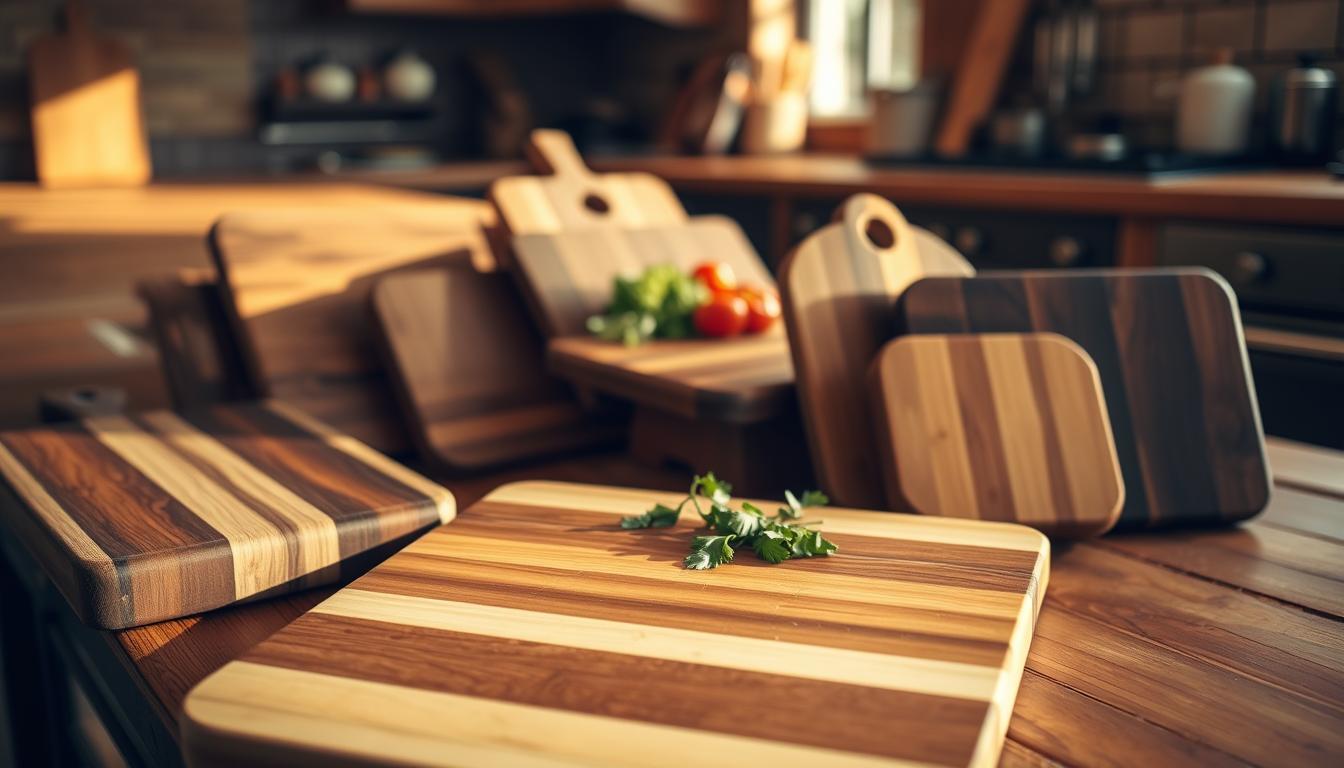Imagine a sunny Saturday morning in the kitchen. Family life is buzzing around us. The air is filled with the scent of fresh herbs as we prepare for brunch.
On the counter, a solid wood cutting board sits. It’s aged beautifully, with grooves that tell stories of meals and memories. This cutting board is more than a surface; it’s a trusted friend in our cooking.
The kids are excited to help, reaching for their favorite veggies. We know not all cutting boards are the same. So, we looked at 21 options, checking their durability, looks, and how well they work.
We found some top-rated cutting boards that everyone loves. From the durable Boardsmith to the affordable Ironwood Gourmet Acacia, there’s a great choice for everyone.
Whether you’re a pro chef or just starting, let’s explore these high-quality cutting boards. We’ll find the best ones to make our cooking better and our family moments special.
Introduction to Solid Wood Cutting Boards
In our kitchens, solid wood cutting boards are key tools. They’ve been around for over 5,000 years, starting in 3000 BC. Made from hardwoods like maple, walnut, and cherry, they look great and help with cooking.
Hardwood cutting boards are durable and can heal themselves. Unlike softer woods, they don’t scar easily. With a little care, they can last for years, helping us in the kitchen.
These boards bring a sense of nostalgia to cooking. Their natural beauty makes kitchens feel warm and inviting. They remind us of the joy of cooking together as a family.
Why Choose Solid Wood Cutting Boards?
Solid wood cutting boards are great for kitchens. They make cooking better and last longer. They also help your kitchen tools last longer.
Durability and Longevity
High-quality cutting boards can last over a decade with care. They should be at least 1¾ inches thick. This keeps them strong and prevents damage.
Choosing a solid wood board is smart. It’s strong and works well for daily use.
Gentle on Knives
Hardwood cutting boards, like maple, are easy on knives. They don’t dull knives like plastic does. Wooden boards, like end-grain, keep knives sharp longer.
This means you sharpen knives less often. It makes cooking better.
Natural Antiseptic Properties
Wood fights bacteria better than plastic. It’s safe for raw meats, poultry, and seafood. This makes it a good choice for those who care about cleanliness.
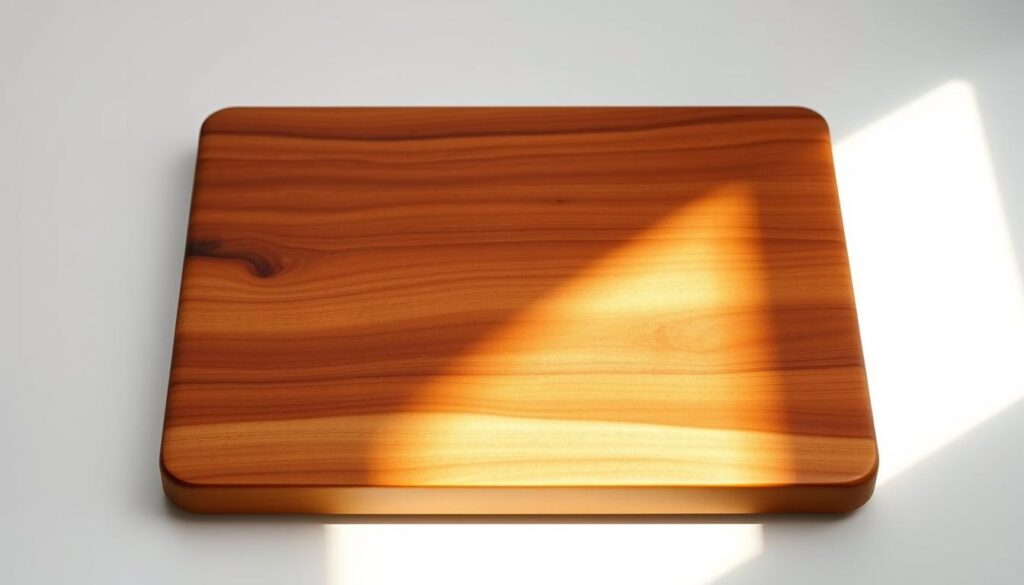
Top Picks for Solid Wood Cutting Boards
We’ve spent over 200 hours researching and testing solid wood cutting boards. We’ve looked at more than 25 cutting boards. Our list includes the best overall cutting board, a budget-friendly option, and a top choice for chefs.
Best Overall: The Boardsmith Maple End Grain Cutting Board
This cutting board is top-notch for its durability and how well it handles knives. It’s 18 by 12 inches and made from FSC-certified maple. It’s 2 inches thick, making it very sturdy.
The end grain construction means it can fix cuts on its own. This makes it the best overall cutting board for serious cooks.
Best Budget: Ironwood Gourmet Acacia Wood Cutting Board
If you’re on a budget but want quality, this cutting board is a great choice. It’s made from beautiful acacia wood. It’s 16 by 11 inches and about 1.25 inches thick.
It’s a practical choice for everyday use. It’s one of the top-rated kitchen boards, perfect for beginners.
Best for Home Chefs: John Boos Maple Edge-Grain Board
This maple edge-grain board is a favorite among chefs. It’s 20 by 15 inches and 1.25 inches thick. It’s very stable and versatile.
John Boos boards are made with care. They become essential tools in any home cook’s kitchen.
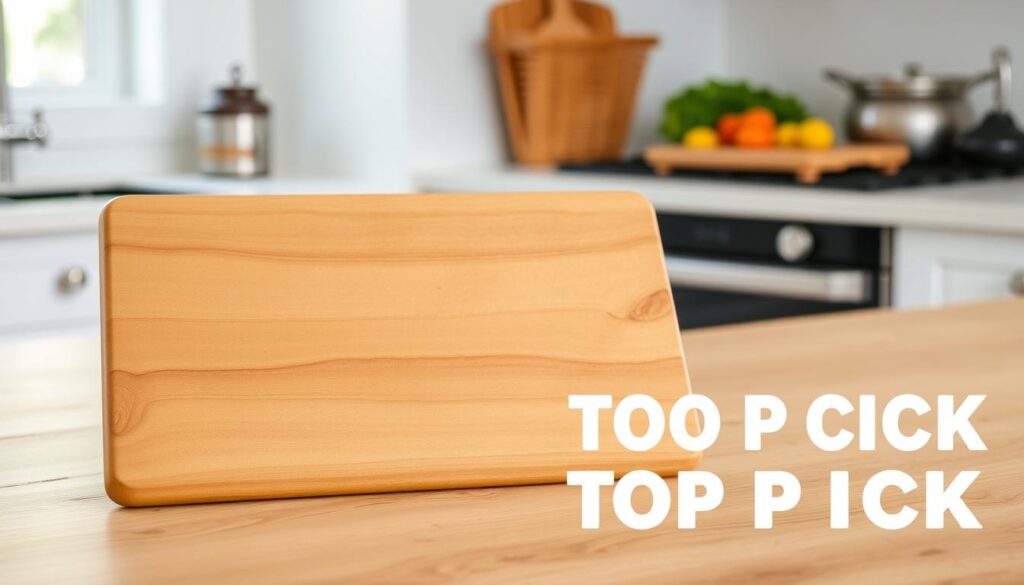
Benefits of Handcrafted Cutting Boards
Handcrafted cutting boards make cooking better with their quality and design. They have unique wood designs that make any kitchen special. This adds art to our cooking spaces.
Artistic Quality and Design
Every handcrafted cutting board is a unique piece of art. It shows the beauty of nature’s imperfections. The different textures and colors in solid wood make our kitchens look better, making cooking more enjoyable.
Personalization Options
These cutting boards can be personalized, making them special. They’re great for gifts or family keepsakes. They add a personal touch to our cooking.
Sustainable Sourcing Practices
Many makers focus on sustainable products, using wood responsibly. Choosing a handcrafted cutting board supports talented craftsmen. It also helps protect our planet, aligning with our values.
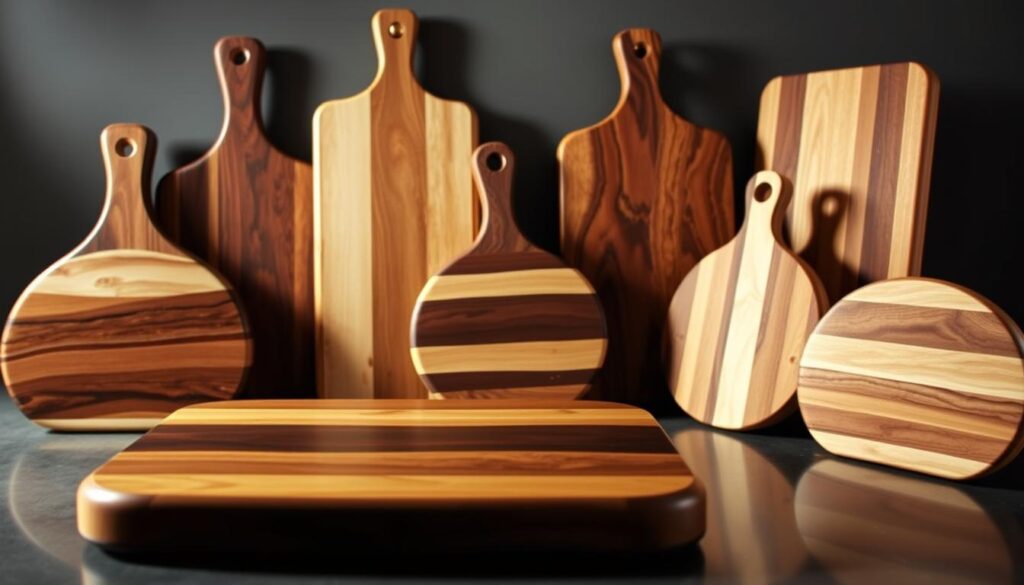
Comparing End-Grain vs. Edge-Grain Cutting Boards
Choosing the right cutting board is important. Knowing the difference between end-grain and edge-grain boards helps us make better choices. Each type has its own benefits for cooking.
Understanding the Construction
End-grain boards are made from small wood blocks in a checkerboard pattern. This makes them strong and able to handle heavy use. The knife blades slide between the wood fibers, making the board self-healing and less likely to show knife marks.
On the other hand, edge-grain boards are made from long wood strips laid vertically. They are lighter and easier to move around in the kitchen.
Pros and Cons of Each Type
Let’s look at the pros and cons of each cutting board style:
| Feature | End-Grain Boards | Edge-Grain Boards |
|---|---|---|
| Price Range | $150 – $300 | More affordable |
| Durability | Exceptional; resists deep knife marks | Moderate; develops visible marks over time |
| Moisture Absorption | Slower absorption | Less absorbent |
| Knife Friendliness | Keeps knife edges sharper | Can dull knives faster |
| Recommended Maintenance | Frequent oiling required | Less frequent oiling |
| Weight | Heavier | Lighter and easier to handle |
Understanding the differences between end-grain and edge-grain boards helps us pick the best one for our cooking. Each type is suited for different cooking needs, making our kitchen experience better and encouraging us to try new recipes.
Caring for Your Wood Cutting Board
To keep your solid wood cutting boards in great shape, regular care is key. Simple maintenance routines can greatly extend their life and use. Cleaning your board well prevents problems and keeps it clean.
Cleaning and Maintenance Tips
Always wash the board’s surface and sides after each use. This quick step prevents warping and keeps your board clean. A mild soap and water mix works well. For extra freshness, try lemon juice and kosher salt.
Seasoning with Food-Safe Mineral Oil
Seasoning your wooden cutting boards with food-safe mineral oil is important. Apply a thick layer to all surfaces monthly or when they look dry. New boards need oiling every couple of days for a week, then weekly for a month. This stops cracking and drying.
Preventing Warping and Cracking
Keep your board dry to avoid damage. Wood expands and shrinks with humidity and temperature changes. This can cause cracks if not handled right. Regular maintenance, like oiling and checking for wear, keeps your board in top shape for years.
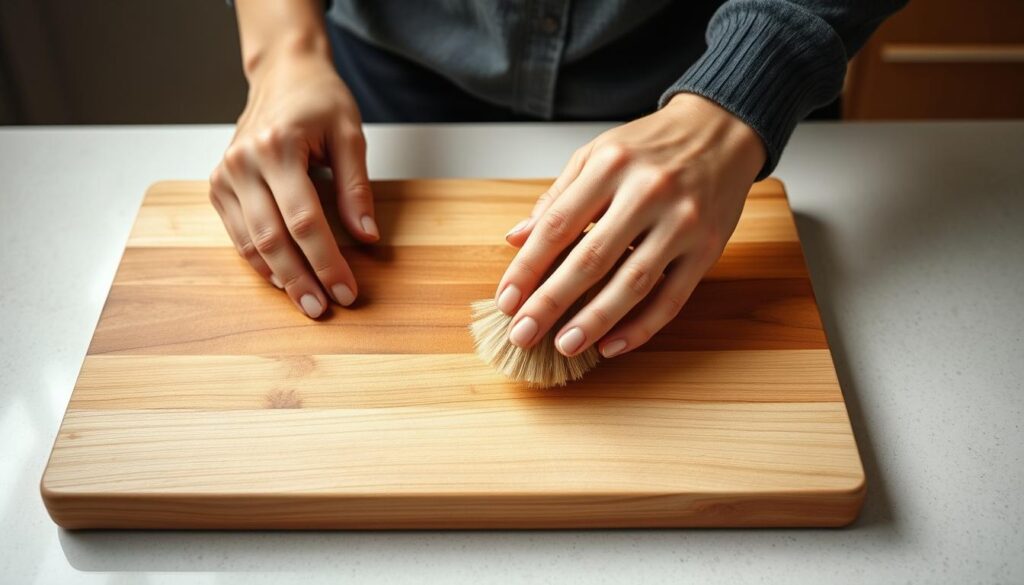
Wood Types Used in Cutting Boards
Choosing the right wood for cutting boards is key. It affects how well they work and how they look in your kitchen. Let’s look at some popular hardwoods and their benefits.
Popular Hardwoods: Maple, Walnut, and Cherry
Maple is a top choice for cutting boards. It has a Janka hardness rating of 1450, making it strong and durable. Its grain structure also helps prevent bacteria growth, which is important for food safety.
Walnut is another great option. It has a rating of 1010 and a beautiful dark finish. It looks great in many kitchen styles. Cherry boards are known for their warm tones and age well, adding charm to any kitchen.
Benefits of Organic Wood Options
Choosing organic cutting boards is good for the environment and our kitchens. These boards are made from sustainable wood sources. They help us prepare healthier meals for our families.
Understanding the different types of wood for cutting boards helps us make better choices. We can choose wood that fits our values and enjoy quality craftsmanship.
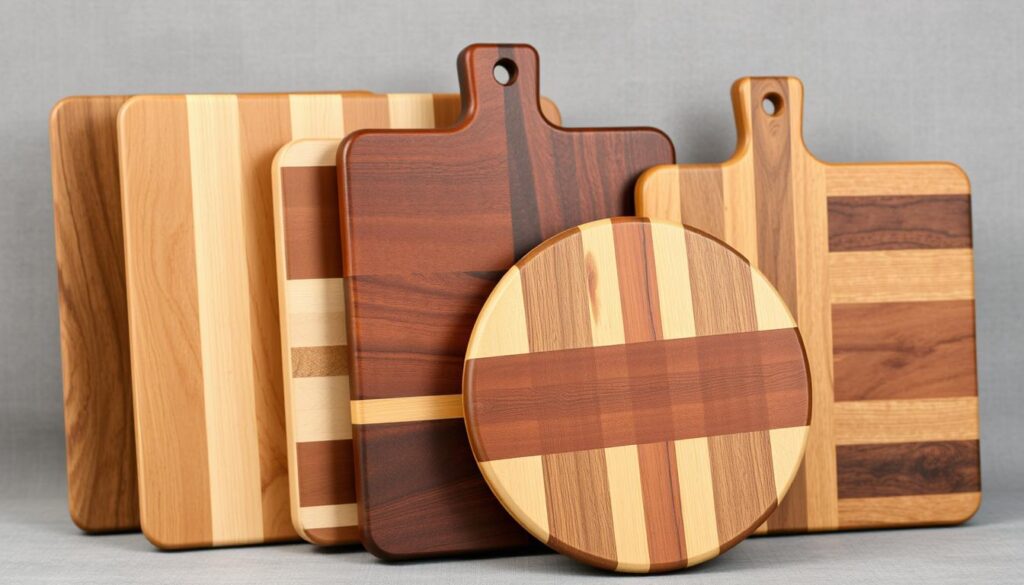
Custom Wood Cutting Boards for Unique Kitchen Aesthetics
Custom wood cutting boards bring beauty and function to our kitchens. They show off our personal style and are great for cooking. Each board is made with care in the USA, combining quality and beauty.
Making a Statement with Design
Adding a custom wood cutting board to our kitchen decor makes a big statement. We can choose from maple, walnut, cherry, and olive wood, showing off our taste. These boards are thick, up to 2 inches, making them sturdy and artistic.
Engraved designs, like monograms, are becoming more popular. They mix style with sentiment, making cooking an art. This unique decor is loved by both home cooks and chefs, turning meal prep into a special experience.
Personalized Gifts for Culinary Enthuasiasts
Custom wood cutting boards are perfect for special occasions like weddings or housewarmings. They encourage us to make memories while cooking. Each board is a keepsake that shows our love for cooking together.
With more people wanting customized kitchen items, these boards are a great choice. They not only make cooking better but also strengthen our bonds with family and friends.
Solid Wood Cutting Boards as Versatile Kitchen Essentials
Solid wood cutting boards are more than just kitchen tools. They make our cooking and entertaining better. These boards go from prep to presentation, making them key in our kitchen.
Multi-Functionality: From Prep to Presentation
These cutting boards are great for chopping veggies and serving dishes. They are sturdy, making prep easier. And they look good as platters, adding to our presentation.
Ideal for Charcuterie Board DIY
Making charcuterie boards on a wooden cutting board is fun. The wood’s natural look is perfect for cheeses, meats, and fruits. It lets us get creative, impressing our guests and celebrating our cooking.
- Transition smoothly between tasks.
- Enhance presentation with natural aesthetics.
- Facilitate creativity in charcuterie board designs.
| Board Type | Dimensions | Weight | Thickness | Price Range |
|---|---|---|---|---|
| John Boos Maple Edge-Grain | 15 x 20 inches | 12 pounds | 1.5 inches | $40 – $150 |
| Teakhaus Edge-Grain | 15 x 20 inches | $100 (available in 12 x 16 inches and 18 x 24 inches) | N/A | $100 |
| Boardsmith Maple End-Grain | Dimensions may vary | N/A | 2 inches | $100 – $150 |
Environmental Impact of Choosing Sustainable Cutting Boards
Thinking about our kitchen choices shows how important sustainable cutting boards are. Every choice we make can help our planet. By picking sustainable cutting boards, we improve our cooking and help the environment.
Eco-Friendly Sourcing and Production
Choosing wood from responsible sources is key to eco-friendly wood sourcing. The Forest Stewardship Council (FSC) shows us how to do this right. It ensures wood is harvested without harming forests or ecosystems. Brands that follow these steps help us enjoy cooking without harming the planet.
Minimizing Waste in Wooden Projects
Woodworking is getting better at using less waste, which is great for the environment. By using every bit of wood, makers create boards that last longer and need to be replaced less often. Even though they cost more upfront, they save money in the long run.
Consumer Reviews and Insights on Best-Selling Cutting Boards
Looking into customer reviews of cutting boards reveals key insights. These reviews talk about durability, performance, and looks. They help us make better choices when buying.
What Users Love About These Products
Home cooks love the solid wood cutting boards for many reasons:
- Durability: Boards like the John Boos Maple and San Jamar Saf-T-Grip are praised for lasting long.
- Knife Maintenance: They keep knives sharp and provide a strong surface for chopping.
- Aesthetic Appeal: The natural beauty of wood adds charm to kitchens, making them great for cooking and serving.
Common Critiques and Considerations
Some users have shared common concerns:
- Weight: Heavy boards can be hard to handle and store.
- Maintenance Requirements: Boards like the John Boos need regular oiling, which some find inconvenient.
- Storage Challenges: Large boards, like the OXO Good Grips, can be tough to store in small kitchens.
Feedback on best sellers shows a wide range of preferences. Whether you want an eco-friendly bamboo board or a traditional solid wood one, customer insights are invaluable. They help us understand what meets expectations and what to think about when buying.
Conclusion
Solid wood cutting boards offer many benefits for different cooking styles. They make our cooking experiences better, both practical and beautiful. These boards last longer than plastic ones with the right care.
They also help reduce the risk of cross-contamination. Using them, we strengthen our bonds with family and friends over meals.
Choosing the right cutting board means looking at hardwood’s special features. Its antimicrobial properties and knife-friendly surfaces are big pluses. Plus, picking sustainable wood is good for the planet.
This choice makes our kitchens better and helps our environment. It’s a smart move for today’s eco-aware people.
Investing in solid wood cutting boards means you’re choosing durability, cleanliness, and eco-friendliness. With a bit of care, they can last over a decade. They make our cooking memories last forever.

